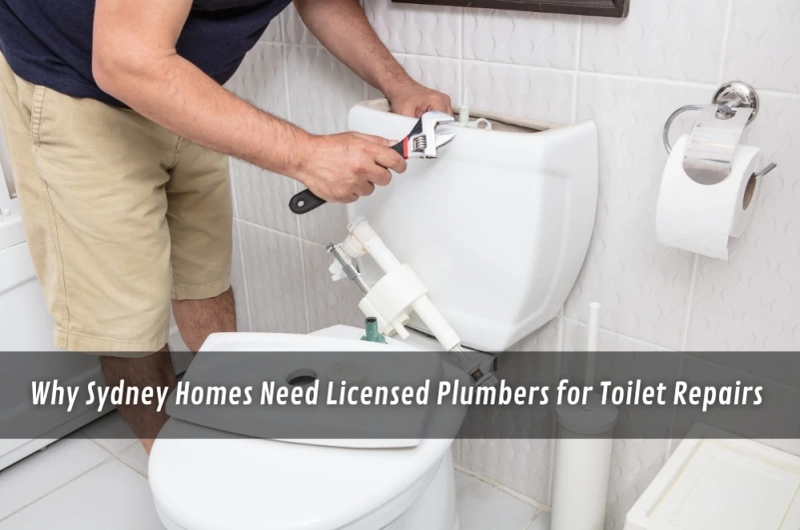Ever notice how the smallest plumbing problems always seem to show up at the worst time? A toilet that won’t stop running, a faint drip behind the cistern, or that slow refill you keep meaning to fix — it’s all part of life in a busy Sydney home. Most people try a quick tweak or two, but some issues need a closer look. That’s when reliable toilet repairs Sydney services like Apex Plumbing Services quietly step in to keep everything running as it should. It’s not about big emergencies — more about catching small problems before they turn into major disruptions. After all, a steady, well-working toilet isn’t just convenient; it’s one of those everyday comforts you only notice when it stops working.
Early signs your toilet needs attention
Minor clues arrive before the big messes. Catching them early keeps the fix straightforward and the bathroom usable:
- A faint hiss or occasional “phantom flush” after the tank refills
- Water lines on the inside of the bowl that never seem to clear
- Dampness at the base or a subtle wobble when you sit
- Gurgling from nearby drains after a flush — a hint that the vent or line isn’t breathing well
When these show up together, the issue often isn’t just one worn part. It can be a mix of inlet valve wear, a tired flapper, mineral build-up, or a seal that’s past its best. In many Sydney homes, older pipework and mixed renovations add a layer of complexity. A careful inspection — lid off, isolation tap tested, dye in the cistern — quickly separates a simple component swap from a deeper drain or vent concern.
Why licensing matters in NSW
In New South Wales, plumbing isn’t something anyone can just pick up — it’s a trade built on strict safety and quality standards. Those rules exist for a reason: to keep water clean, waste contained, and homes structurally sound. When you hire licensed plumbers in NSW, you’re choosing professionals who are trained, insured, and accountable for the work they do. NSW Fair Trading oversees who is qualified to do the job and what competency sits behind the licence — helpful when you want the fix to last and the paperwork to be clear.
- Seals and collars set to spec so wastewater stays where it belongs
- Venting and trap depth checked to stop sewer gas and slow drains
- Compatible parts matched to the suite, rather than “near enough” components
- Clear documentation of what was done, which helps if you ever need evidence of compliant work
A calm way to decide between quick fixes and deeper work
Not every noisy cistern signals a major job. A smart path is to weigh the pattern of symptoms, the age of the suite, and any history of repeat faults. If a flapper or fill valve is at fault, a tidy swap and proper tuning can restore a quiet, efficient refill. But when the pan rocks, the base shows dampness, or clogs return soon after a plunge, the better move is to lift the toilet, renew the pan collar, and inspect the waste line.
A short conversation about your home’s era and previous renovations helps too. Post-war cottages, 90s renos, and new apartments all hide different quirks — from pan footprints that don’t match modern suites to tight access behind the cistern. The right fix acknowledges those realities and keeps you from repeating the same repair later.
Handling urgent issues without panic
If water won’t stop running or a base leak appears, slowing things down — rather than rushing — tends to work best. Turn the isolation tap a quarter-turn clockwise, lift the lid, and look for obvious wear. When the leak sits under the pan or the bowl sends bubbles through nearby drains, it’s time to seek help. In that situation, booking emergency toilet repair keeps the sequence tight: stabilise, diagnose, then fix what’s actually causing the problem.
A quick story from the field: I arrived at a terrace with a “constant trickle.” The flapper looked new, so I checked the chain length, then the inlet valve. Grit had scored the seal. A fresh, pressure-appropriate valve and a modest adjustment to the fill level solved it. The tell was dye drifting into the bowl, even with the flapper seated — a small sign pointing to the real culprit.
- Turn the isolation tap off first; it buys you time to think
- Note what you hear: hiss, gurgle, or silence after a flush tells you where to look
- Avoid makeshift tools; a scratched seal or cracked fitting invites a second repair
- If the pan shifts, stop. Movement can break seals faster than you can tighten bolts
Common mistakes that make repairs drag on
Small errors can multiply, especially in tight spaces or older bathrooms. A few pitfalls to sidestep:
- Overtightening cistern or pan bolts, which can crack porcelain or compress seals unevenly
- Using generic internals that don’t match the suite, leading to weak flushes or noisy refills
- Siliconing around a leaking base without replacing the pan collar
- Ignoring nearby symptoms — slow basin drains or a smelly floor waste can flag a broader issue
The theme here is simple: aim for a repair that fixes the cause, not just the symptom. When the toilet behaves but another fixture gurgles, the system itself wants attention.
Keeping maintenance simple
Toilets don’t usually need much attention, but a little awareness goes a long way in keeping them reliable. Every so often, lift the cistern lid, listen to the refill, and make sure it shuts off smoothly. A slow fill or the occasional gurgle might not seem like much, but these can be early signs of common toilet problems such as minor leaks, worn seals, or mineral build-up from Sydney’s water supply. For practical, trade-grounded tips on everyday plumbing habits, the Master Plumbers Association of NSW often highlights sensible maintenance that aligns with professional standards.
By recognising these small clues, you can catch issues before they turn into bigger repairs. It’s not about overthinking it — just staying observant enough to notice when something’s off.
- Test the isolation tap now and then so it doesn’t seize up
- Use a flange plunger designed for toilets, not a flat sink plunger
- Keep a small torch handy; a quick look under the pan can reveal early dampness
- If you’re in a multi-storey setup, pay attention to fixtures on the level below the bathroom
Local factors in Sydney bathrooms
Sydney’s mix of housing stock and water conditions adds quirks worth knowing. Older clay or cast lines might invite roots; newer apartments can squeeze access behind the cistern. Water chemistry can stiffen valves and narrow rim jets. After storms, drains in older suburbs sometimes breathe differently — a reminder that the toilet is part of a wider system.
- Expect small variations in refill sound and speed across different suburbs and building ages
- Keep an eye on pan movement on timber floors; tiny shifts can fatigue seals
- When renovating, match the new suite’s footprint and set-out to the old one to avoid odd gaps
- Document past fixes; a brief history helps the next repair land right the first time
Final thoughts
A reliable toilet is quiet, steady, and unremarkable — exactly how it should be. When a fault shows up, treating it as a signal rather than a crisis keeps everything manageable. Start with the simple checks, look for patterns, then bring in help when the symptoms point beyond a single component. Linking decisions to standards and clear evidence gives you a clean, lasting result. If the day comes when quick fixes aren’t cutting it, the combination of a clear symptom rundown and a call to a licensed professional will steady the course and return the room to normal.


